Zebra danios are vibrant freshwater fish belonging to the Cyprinidae family. Known for their small size and active nature, they are ideal for both beginners and seasoned aquarists. In this article, you will discover essential information about keeping zebra danios, their compatibility with other fish species, and how they differ from glofish danios. Understanding these aspects will help you create a harmonious aquarium environment while enjoying the lively presence of these fascinating fish.
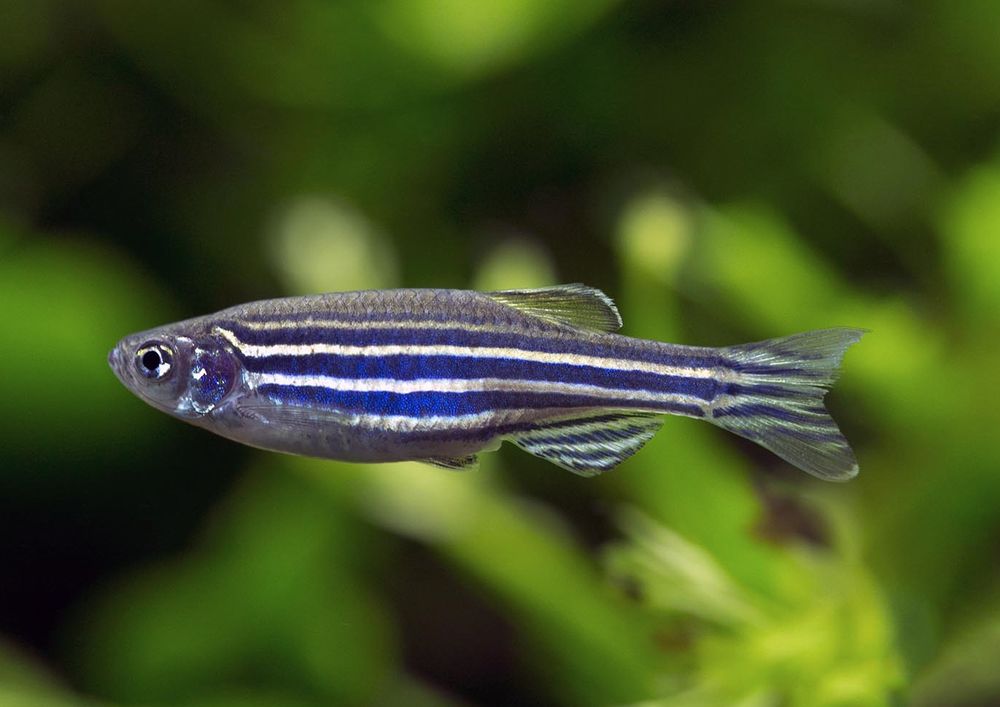
Contents
Habitat in the wild
The zebrafish, known scientifically as Danio rerio, is a member of the Cyprinidae family, often referred to as the carp or minnow family. This vibrant freshwater fish has become a favorite in the aquarium trade and serves as a crucial model organism in scientific research, especially in developmental biology and genetics. Described for the first time in 1822 by Francis Buchanan-Hamilton, a notable figure in Indian natural history, the species is currently classified under the genus Danio.
Native to Southeast Asia, zebrafish thrive in freshwater environments across countries like India, Bangladesh, Nepal, and Myanmar. They inhabit slow-moving or stagnant waters such as ponds, rice paddies, and small streams, often surrounded by dense aquatic vegetation that provides shelter and breeding sites. Their seasonal behavior influences their habitat choices; during the dry season, adults can be found in temporary puddles and flooded rice fields, where they feed and spawn. After the rains, they return to larger rivers and bodies of water.
In the wild, zebrafish primarily feed on small invertebrates, zooplankton, and insect larvae. Their striking blue and silver striped pattern not only serves as camouflage but also enhances their appeal in both scientific and aquarium contexts. This unique appearance, combined with their adaptability, makes them an iconic species in various fields.
Zebrafish are especially valued in genetic research due to their transparent embryos, which allow scientists to observe developmental processes in real time. They can regenerate damaged tissues, providing insights into regenerative medicine. Furthermore, their ability to detect changes in their environment contributes to their survival, while their social behavior includes forming shoals that influence feeding and mating strategies. The species has also been instrumental in studies of disease, including cancer, cardiovascular health, and neurological disorders.
Description
Size
The size of a zebrafish can vary, but they typically reach an adult length of about 2 to 2.5 inches (approximately 5 to 6.5 centimeters). This size makes them relatively small and well-suited for community aquariums, where they are popular due to their active behavior, striking appearance, and ease of care. Keep in mind that individual zebrafish can vary slightly in size, and proper care and diet can influence their growth.
Lifespan
This is a small fish which means that it doesn’t live long. However, provided with proper conditions, zebra danio can live about 3-4 years.
Coloring
The zebrafish features a fusiform, silvery body adorned with bright blue stripes that create a striking appearance. Young zebrafish have relatively short fins, but as they mature, these fins elongate and can develop a beautiful veil-like shape; there are also long-finned varieties. The edges of their fins may display a hint of yellow, adding to their visual appeal.
Additionally, zebrafish possess a pair of tiny downward-facing barbels located at the corners of their mouths, which aid in sensing their environment and locating food. The vibrant blue stripes of zebrafish serve as a means of communication among individuals, particularly during mating displays. This combination of physical traits makes zebrafish not only captivating to observe but also well-adapted to their aquatic habitats.
Variations and Color Morphs of Zebrafish
Zebrafish exhibit a range of recognized variations and color morphs, each with its own unique appearance. Here are some notable types:
Wild-type Zebrafish
The wild-type zebrafish represents the most common and natural form, characterized by its silver body adorned with horizontal blue stripes. This classic look not only makes them popular in the aquarium trade but also serves as an important model for ecological studies. Wild-type zebrafish play a crucial role in research as indicators of environmental health in their native habitats.
Leopard Danio
The leopard danio features spots on its body in addition to the usual stripes. These spots, which may be black or dark brown, create a distinctive “leopard” pattern that adds visual interest. This pattern not only enhances their aesthetic appeal but also aids in camouflage, helping them blend into their surroundings and evade predators.
Longfin Zebrafish
Longfin zebrafish are known for their longer, flowing fins compared to the standard wild-type. This trait has emerged as a result of selective breeding, making them particularly appealing in aquariums. The longer fins contribute to their graceful swimming motion, captivating observers.
Albino Zebrafish
Albino zebrafish lack pigmentation, resulting in a pale, almost translucent appearance. Their red eyes, caused by the absence of pigments, give them a strikingly different look. This unique coloration makes them stand out in aquariums, although their sensitivity to light may require special care.
GloFish Zebrafish
GloFish are genetically modified zebrafish that express fluorescent proteins, producing vibrant colors when exposed to certain lighting. Varieties include Electric Green, Cosmic Blue, and Sunburst Orange. These fish were the first genetically modified pets approved for sale in the United States, showcasing the intersection of science and aquarist interests. The genetic modifications allow them to fluoresce under UV light, creating a captivating display that is particularly popular among aquarium enthusiasts.
| Characteristic | Description |
|---|---|
| Scientific Name | Danio rerio |
| Family | Cyprinidae (Carp family) |
| Native Range | Southeast Asia (India, Bangladesh, Nepal, Myanmar) |
| Habitat | Freshwater: Ponds, rice paddies, ditches, small streams |
| Size | Typically 2-2.5 inches (5-6.5 cm) in length |
| Lifespan | Average 2-3 years (can vary with care and environment) |
| Coloration | Silver with distinctive horizontal blue stripes |
| Behavior | Peaceful, active, schooling fish |
| Diet | Omnivorous – small invertebrates, zooplankton, insect larvae, and flake/pellet foods |
| Aquarium Suitability | Popular in the aquarium trade; hardy and adaptable |
| Breeding | Egg-scattering species, relatively easy to breed in captivity |
| Use in Research | Widely used as a model organism in genetics and developmental biology studies |
| Importance | Significant in genetics research, aquaculture, and the aquarium trade |
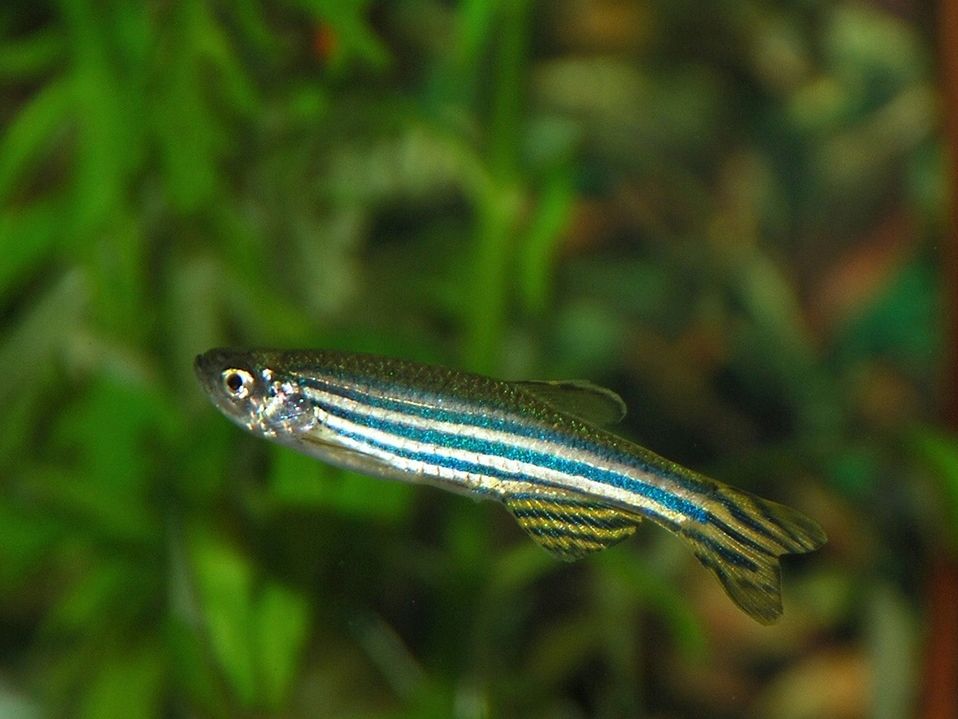
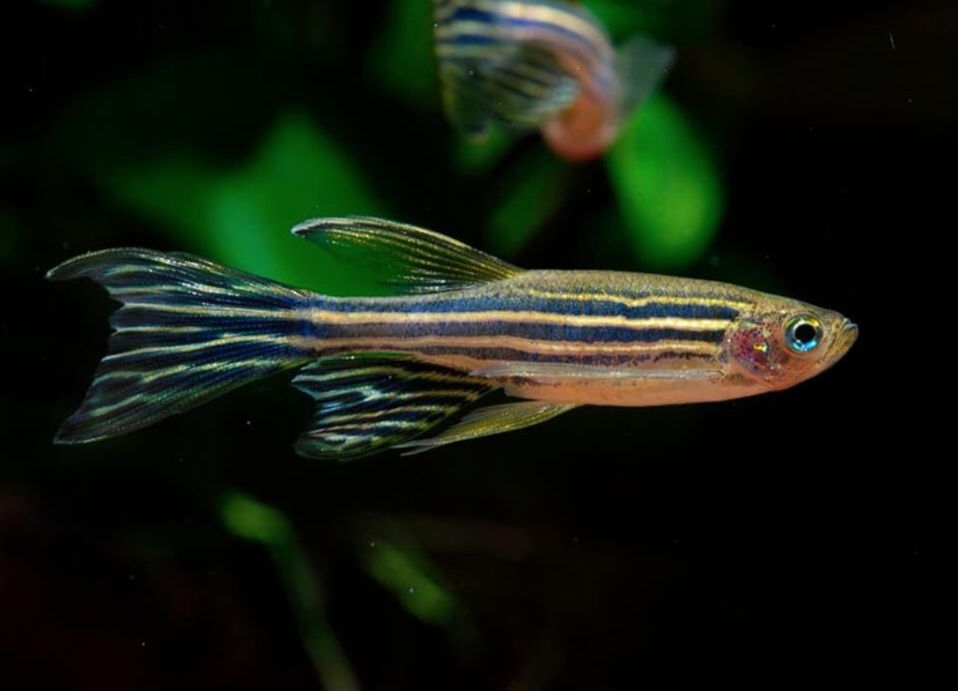
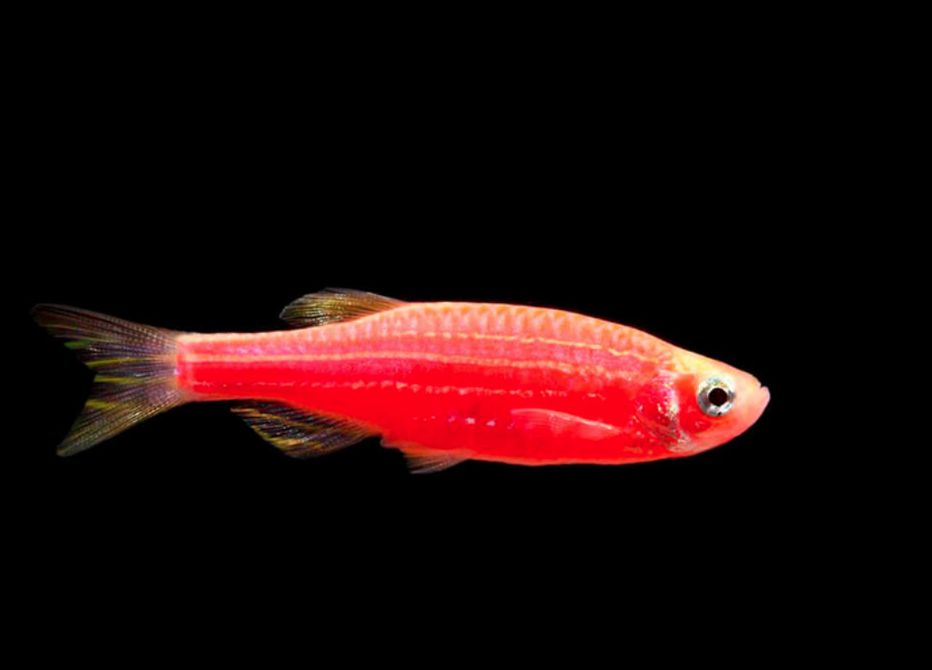
Zebrafish as a model organism
Zebra danio is a popular model organism in biology for studying embryogenesis and the genetics of vertebrates. This is largely due to their rapid egg development; it takes only three days for the embryos to grow from eggs to larvae. The embryos are relatively large and resilient, allowing researchers to perform various manipulations. Notably, zebrafish were the first genetically modified fish, and the story of the famous fluorescent GloFish began with Danio.
American molecular biologist George Streisinger proposed zebra danio as a model organism for studying vertebrate embryogenesis and gene function. The significance of this model has been validated by numerous genetic researchers, highlighting its role in advancing our understanding of developmental biology. Their genetic similarity to humans—approximately 70%—enhances their relevance in biomedical research.
Zebra danios have also been among the few fish species used in experiments in space, being sent to both the International Space Station (ISS) and Salyut 5. When studying Danio rerio, several advantages become apparent compared to other vertebrates. The rapid development of their embryos allows for quick observations and experiments, facilitating research in various biological fields. Additionally, their transparency during early development enables real-time observation of organ formation and cellular processes.
There is significant potential in using zebra danio for screening potential medicines due to its speed and convenience. Despite the relatively low genetic similarity between fish and humans, many biological systems, including the cardiovascular system, respond similarly to low-molecular compounds. This similarity enables consistent results when studying the pharmacokinetics and toxicological characteristics of various medications. Furthermore, zebrafish are used to model human diseases, providing insights into disease mechanisms and potential treatments.
Advancements in genetic engineering methods may lead to the development of new zebrafish strains that specifically mimic various human diseases. This capability is invaluable for studying complex conditions such as cancer, heart disease, and neurological disorders. The ability to breed zebrafish in large numbers allows for extensive statistical analyses, increasing the reliability of research findings.
Zebrafish can also regenerate damaged tissues, including spinal cords and heart muscle, offering a unique perspective on regenerative medicine. Their social behavior, such as shoaling, can be studied to understand group dynamics and communication in vertebrates, further enriching the scientific knowledge base.
Difficulties in keeping
Zebra danio is a good-looking and unpretentious fish, a perfect choice for beginning aquarists, and an excellent choice for a community tank. Zebrafish eats any food that you give it. The fish easily stands various tank water parameters, and it can live even without heating the tank water.
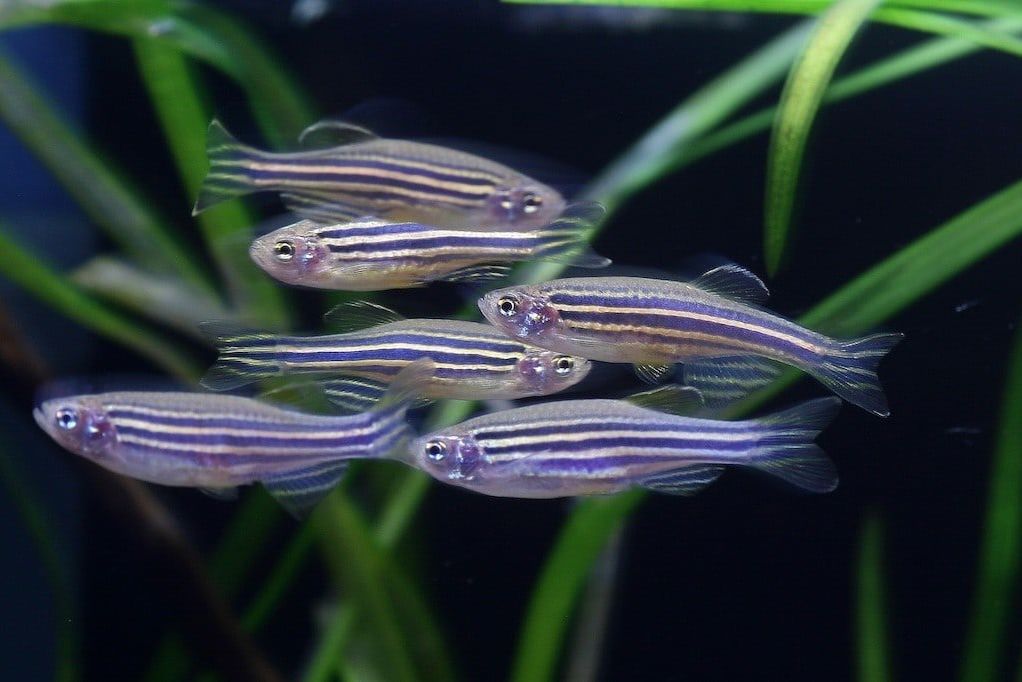
Care and keeping in a tank
Zebra danios are remarkably undemanding and capable of thriving in a variety of tank conditions. However, they do have specific preferences that should be considered to ensure their well-being.
These fish primarily inhabit the upper layers of the water column, so additional aeration is typically unnecessary. Providing a long tank is preferable, as zebra danios are very active and enjoy chasing their tank mates. A spacious environment allows them to swim freely and exhibit their natural behaviors.
One important consideration is their tendency to jump when they feel threatened. To prevent accidents, it’s essential to cover the tank with a lid. The optimal distance from the water surface to the lid should be about 5 cm (2 inches). This gap ensures that if a zebra danio does jump, it won’t be injured by hitting the hard surface of the lid.
Overall, maintaining a suitable environment for zebra danios enhances their quality of life, allowing them to thrive and display their lively personalities.
Tank size
Zebra danios thrive in groups, making it ideal to keep them in schools of at least five individuals or more. This social structure encourages their natural behaviors, resulting in more active and less stressed fish. To accommodate a school of zebra danios, a tank with a minimum capacity of 40 liters (10 US gallons) is recommended. However, providing a larger space is even better, as it allows the fish ample room to swim and explore their environment.
A spacious tank not only promotes healthy social interactions but also helps reduce territorial disputes and stress. In addition to adequate space, incorporating plenty of plants and hiding spots can further enhance their habitat, providing enrichment and comfort for the fish.
Water parameters
Zebra danios are relatively hardy and adaptable freshwater fish, capable of tolerating a range of water parameters, which makes them suitable for various aquarium setups. However, to ensure their well-being and minimize stress, it’s essential to provide stable and appropriate water conditions.
For optimal health, the recommended water parameters for zebra danios are as follows:
Temperature: Zebrafish thrive in a temperature range of 74-78°F (23-26°C), ideal for most tropical community aquariums. While they can technically be considered cold water dwellers, as they naturally inhabit waters around 18-20°C (64-68°F), they have adapted well to various tank conditions. In fact, zebra danios can live comfortably in tanks without water heating within a range of 18 to 25°C. They can also withstand short-term fluctuations, tolerating temperatures as low as 15°C and as high as 30°C. However, maintaining a stable temperature around 74-78°F (23-26°C) is preferable, as it enhances their disease resistance.
pH: The optimal pH range for zebra danios is between 6.5 and 7.5, allowing them to thrive in slightly acidic to slightly alkaline conditions. Regular monitoring of pH levels is crucial, as sudden shifts can cause stress.
Water Hardness: Zebrafish can adapt to moderate water hardness levels. A general hardness (GH) of 5-15 dGH and a carbonate hardness (KH) of 3-8 dKH are suitable for their health.
Ammonia, Nitrite, and Nitrate: Keeping ammonia and nitrite levels at zero is essential, as both substances are toxic to fish. Nitrate levels should be maintained below 20-30 ppm through regular water changes, ensuring a safe environment for your fish.
Water Quality: Effective filtration is crucial for maintaining water quality, as it helps remove waste, ammonia, and nitrites from the tank. Regular water changes—about 25-30% of the tank volume every 1-2 weeks—are also vital for sustaining a healthy habitat.
It’s important to avoid sudden changes in water parameters, such as temperature or pH, as these can stress the fish. When introducing new fish or making adjustments, do so gradually to promote acclimatization and minimize stress.
Tank setup: decorations and plants
Zebra danios have no specific requirements regarding tank decorations or plants, as they generally do not disturb them. However, their active nature necessitates ample swimming space. To create an ideal environment, it’s recommended to position long-stalked plants along the tank walls, which provides visual interest without encroaching on their swimming area. This setup allows zebra danios to explore and swim freely in the central part of the tank while enjoying the benefits of a well-planted environment. Additionally, incorporating rocks or driftwood can create hiding spots that enhance their habitat without restricting movement.
Overall, maintaining an open swimming area while using vertical space for plants ensures that zebra danios thrive and exhibit their lively behaviors.
Filtration
Zebra danios thrive in clean water, so ensuring proper filtration and aeration is important for their health. Good filtration helps maintain water quality by removing waste and toxins, while aeration keeps oxygen levels stable, promoting a healthy environment. However, these fish are quite hardy and adaptable; they can even survive in tanks without specialized filtration or aeration, provided that regular water changes are maintained.
Diet
Wild zebra danios have a diverse diet, eagerly consuming small insects, maggots, and seeds that fall into the water. In the aquarium, they tend to prefer feeding from the water’s surface. Although they can catch food that sinks, they rarely scavenge from the tank bottom. Zebra danios are not particularly demanding when it comes to food, readily accepting various types of live, frozen, or artificial foods.
However, relying solely on live or frozen foods may not fully meet their nutritional needs, as these options often lack the necessary vitamins and balance. Therefore, choosing high-quality artificial food is recommended for optimal health. Providing a varied diet can enhance their coloration and vitality, as diverse nutrition supports their overall health. Since they prefer food that remains on the surface for an extended period, feeding should be done several times a day, offering portions that can be consumed within a few minutes to prevent overfeeding and maintain water quality.
Some aquarists have observed that zebra danios can be trained to recognize feeding times, displaying excitement when it’s time to eat. Incorporating occasional treats, such as finely chopped vegetables or specialized flakes, can further enrich their diet. Additionally, the size of the food should be appropriate to their mouth size to ensure they can easily consume it. Regularly observing feeding behaviors can help aquarists identify any changes in appetite, which may indicate health issues.
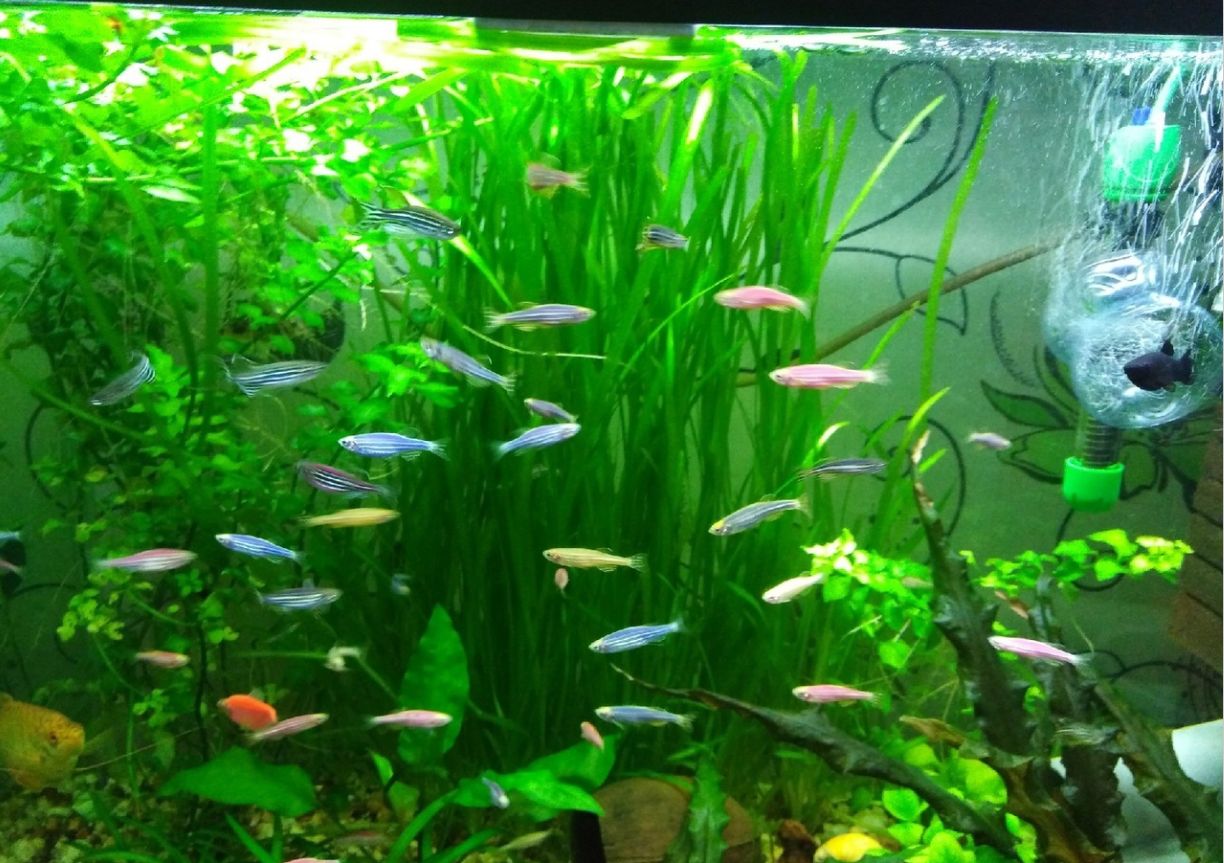
Tank mates
This is a perfect fish for a community tank. It gets on well both with related species and most other tank fishes. You can keep it with small and peaceful fish (not large ones like oscar fish, blood parrot, convict cichlid). For example, bettas, guppies, neon tetras, ember tetra, honey gourami, platy, swordtail are good tank mates for zebra danio.
Any peaceful catfishes (like panda cory, bristlenose pleco) will also be a good choice of the tank mates since they have different feeding niches: catfishes are bottom dwellers while Danio prefers swimming near the water surface. Even bettas don’t pay much attention to these constantly swimming neighbors.
Are zebra danio and goldfish compatible? My answer is no, even though the fish prefers colder water than other tropical fishes. The thing is that goldfishes grow to become quite large, and they are always hungry, so that they may be dangerous for zebra danio. While adult angelfishes won’t be able to swallow zebra danio, despite they’d love to. I’d be careful when keeping zebra danio together with any of these kinds.
Are zebra danios fin nippers? Danio rerio chases each other, but such behavior doesn’t demonstrate aggression. This is how they live in a school. They don’t hurt each other and don’t harm other fishes. It is better to keep at least 5 fish in a tank. Such a school will have its own hierarchy, and it is less prone to stress.
Here are some suitable tank mates for zebrafish:
- Harlequin Rasboras (Trigonostigma heteromorpha)
- Neon Tetras (Paracheirodon innesi)
- Ember Tetras (Hyphessobrycon amandae)
- Glowlight Tetras (Hemigrammus erythrozonus)
- Black Neon Tetras (Hyphessobrycon herbertaxelrodi)
- Cardinal Tetras (Paracheirodon axelrodi)
- Rummy Nose Tetras (Hemigrammus rhodostomus)
- Dwarf Gouramis (Trichogaster lalius or Trichogaster chuna)
- Sparkling Gouramis (Trichopsis pumila)
- Celestial Pearl Danios (Danio margaritatus)
- White Cloud Mountain Minnows (Tanichthys albonubes)
- Dwarf Rasboras (Boraras spp.)
- Endler’s Livebearers (Poecilia wingei)
- Guppies (Poecilia reticulata)
- Platies (Xiphophorus spp.)
- Corydoras Catfish (Corydoras spp. – pygmy cory, panda cory, adolfoi catfish)
- Otocinclus Catfish (Otocinclus spp.)
- Bristlenose Plecos (Ancistrus spp.)
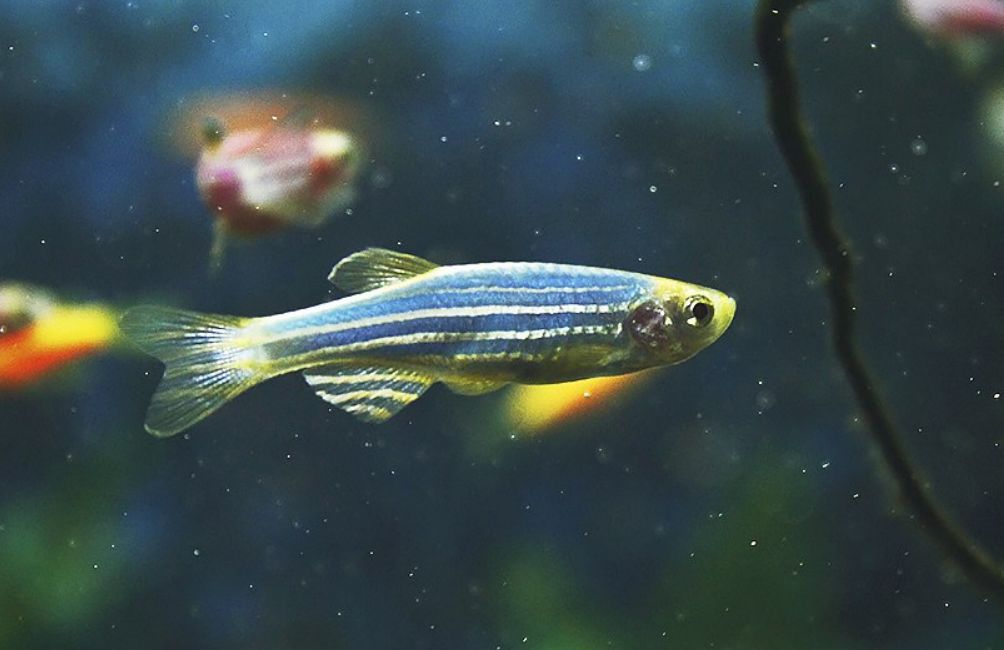
Gender differences: male vs female
Distinguishing between male and female zebrafish can be challenging, especially in young fish. The differences are more noticeable in adults, as juvenile zebrafish are quite similar in appearance. If identifying the gender is crucial for your setup, it’s best to purchase only adult specimens.
As zebrafish mature, several subtle differences become apparent that can help differentiate between males and females:
Size: The most reliable indicator of gender is size. Females are generally larger with a more rounded abdomen, while males are smaller and more streamlined. This difference is linked to the female’s ability to carry eggs, which requires a larger body.
Body Shape: Female zebrafish tend to have a slightly rounder and plumper body shape, particularly when they are carrying eggs. In contrast, males appear slimmer and more streamlined.
Coloration: The intensity of coloration can also be a distinguishing factor. The stripes on female zebrafish are typically paler and less pronounced, whereas males exhibit brighter, more vibrant colors, especially during courtship. This difference is more evident in certain color morphs, such as longfin zebrafish, where males can be particularly colorful.
Anal Fin: A more reliable method for distinguishing gender is to examine the anal fin, which is located near the tail. In males, the anal fin is more pointed and elongated, while in females, it is usually rounder.
Behavior: During breeding or courtship, male zebrafish may display more aggressive behaviors, such as chasing and fin-flaring, while females tend to be less active in these displays.
These differences may not be obvious in juvenile zebrafish, making it easier to identify males and females as they mature and develop reproductive traits. If you’re interested in breeding zebrafish or want to maintain a balanced community, observing their behavior and physical characteristics over time can be beneficial.
Breeding
You will have to separate the zebra danio couple, raise the tank water temperature, and feed the fish intensively to encourage spawning. The rounded body of the female will indicate when she is ready to spawn, typically appearing fuller as she carries eggs.
Use a small tank with a glass bottom for spawning. Experienced aquarists recommend against using sand, as it makes it difficult to see the eggs. Instead, incorporate small-leaved plants, such as java moss, which provide a suitable environment for egg-laying and offer cover for the fry. Take water for the spawning tank from the community tank, ensuring to siphon it first to remove waste and then add fresh, oxygen-rich water.
Keep the water level low in the spawning tank—about 8 cm (3 inches) is sufficient. This will provide around 4 cm (1.5 inches) of water above the moss, allowing the fish to spawn comfortably. Introduce one female and two males into the tank in the evening, ideally placing the setup near a window for natural light.
Interestingly, the water temperature does not play a significant role in the spawning process; zebrafish have been observed to spawn successfully at temperatures as low as 17 °C (63 °F) and as high as 25 °C (77 °F). After acclimating to their new environment overnight, the fish will typically begin spawning in the morning when the plants produce oxygen and the tank is well lit.
During mating, the males exhibit vigorous courtship behaviors, chasing the female and nudging her to encourage egg-laying. This display lasts about 5-6 minutes, with the entire spawning process often completing in less than an hour.
The number of eggs laid can vary greatly based on the female’s readiness and size, ranging from 50 to 400 eggs per spawning event. While it’s possible to obtain offspring from just a couple of zebrafish, it’s generally more successful to use two males and one female to ensure better fertilization. If your spawning tank is spacious enough, you can accommodate multiple breeding pairs.
Once the fish finish laying eggs, promptly remove them from the tank to prevent predation of the eggs. It’s advisable to separate the males and females afterward and reintroduce them after a week or two to prepare for another spawning cycle. Failing to do so can lead to aging eggs, resulting in no viable juveniles, and in some cases, the female may become unable to lay eggs again.
Many aquarists report issues with poor egg quality or a lack of spawning, often due to improper care. Fish kept in warm water and overfed can suffer from overripe eggs that fail to hatch. To prevent this, maintain a water temperature of no higher than 19 °C (66 °F) in winter and avoid excessive feeding.
The incubation period for the eggs depends significantly on the water temperature; at 28 °C (82 °F), juveniles will hatch in about a day and a half, while at 16 °C (61 °F), it may take up to two weeks. Once the larvae emerge, they will cling to plant leaves and tank walls. Initially, feed them infusoria, transitioning to larger food as they grow.
If you maintain the water temperature around 27 °C (81 °F), ensure good aeration, and provide ample food, zebrafish can reach reproductive maturity in about three months. Colder temperatures will slow their growth and development.